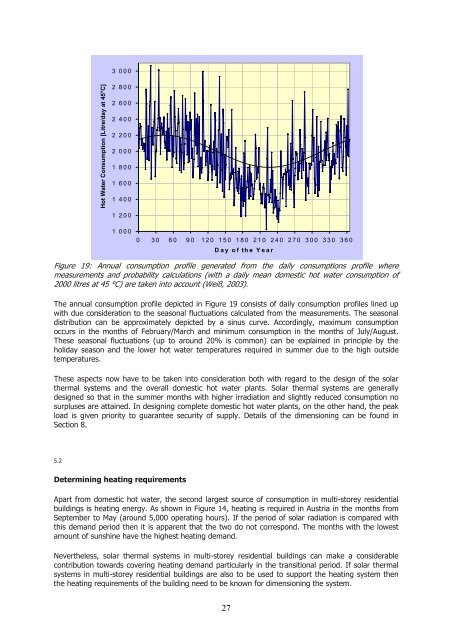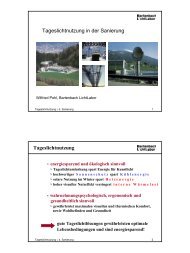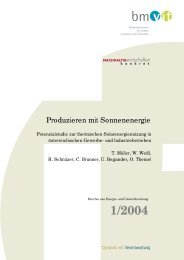Solar-supported heating networks in multi-storey residential buildings
Solar-supported heating networks in multi-storey residential buildings
Solar-supported heating networks in multi-storey residential buildings
You also want an ePaper? Increase the reach of your titles
YUMPU automatically turns print PDFs into web optimized ePapers that Google loves.
Hot Water Consumption [Litre/day at 45°C]<br />
3 000<br />
2 800<br />
2 600<br />
2 400<br />
2 200<br />
2 000<br />
1 800<br />
1 600<br />
1 400<br />
1 200<br />
1 000<br />
0 30 60 90 120 150 180 210 240 270 300 330 360<br />
Day of the Year<br />
Figure 19: Annual consumption profile generated from the daily consumptions profile where<br />
measurements and probability calculations (with a daily mean domestic hot water consumption of<br />
2000 litres at 45 °C) are taken <strong>in</strong>to account (Weiß, 2003).<br />
The annual consumption profile depicted <strong>in</strong> Figure 19 consists of daily consumption profiles l<strong>in</strong>ed up<br />
with due consideration to the seasonal fluctuations calculated from the measurements. The seasonal<br />
distribution can be approximately depicted by a s<strong>in</strong>us curve. Accord<strong>in</strong>gly, maximum consumption<br />
occurs <strong>in</strong> the months of February/March and m<strong>in</strong>imum consumption <strong>in</strong> the months of July/August.<br />
These seasonal fluctuations (up to around 20% is common) can be expla<strong>in</strong>ed <strong>in</strong> pr<strong>in</strong>ciple by the<br />
holiday season and the lower hot water temperatures required <strong>in</strong> summer due to the high outside<br />
temperatures.<br />
These aspects now have to be taken <strong>in</strong>to consideration both with regard to the design of the solar<br />
thermal systems and the overall domestic hot water plants. <strong>Solar</strong> thermal systems are generally<br />
designed so that <strong>in</strong> the summer months with higher irradiation and slightly reduced consumption no<br />
surpluses are atta<strong>in</strong>ed. In design<strong>in</strong>g complete domestic hot water plants, on the other hand, the peak<br />
load is given priority to guarantee security of supply. Details of the dimension<strong>in</strong>g can be found <strong>in</strong><br />
Section 8.<br />
5.2<br />
Determ<strong>in</strong><strong>in</strong>g <strong>heat<strong>in</strong>g</strong> requirements<br />
Apart from domestic hot water, the second largest source of consumption <strong>in</strong> <strong>multi</strong>-<strong>storey</strong> <strong>residential</strong><br />
build<strong>in</strong>gs is <strong>heat<strong>in</strong>g</strong> energy. As shown <strong>in</strong> Figure 14, <strong>heat<strong>in</strong>g</strong> is required <strong>in</strong> Austria <strong>in</strong> the months from<br />
September to May (around 5,000 operat<strong>in</strong>g hours). If the period of solar radiation is compared with<br />
this demand period then it is apparent that the two do not correspond. The months with the lowest<br />
amount of sunsh<strong>in</strong>e have the highest <strong>heat<strong>in</strong>g</strong> demand.<br />
Nevertheless, solar thermal systems <strong>in</strong> <strong>multi</strong>-<strong>storey</strong> <strong>residential</strong> build<strong>in</strong>gs can make a considerable<br />
contribution towards cover<strong>in</strong>g <strong>heat<strong>in</strong>g</strong> demand particularly <strong>in</strong> the transitional period. If solar thermal<br />
systems <strong>in</strong> <strong>multi</strong>-<strong>storey</strong> <strong>residential</strong> build<strong>in</strong>gs are also to be used to support the <strong>heat<strong>in</strong>g</strong> system then<br />
the <strong>heat<strong>in</strong>g</strong> requirements of the build<strong>in</strong>g need to be known for dimension<strong>in</strong>g the system.<br />
27














